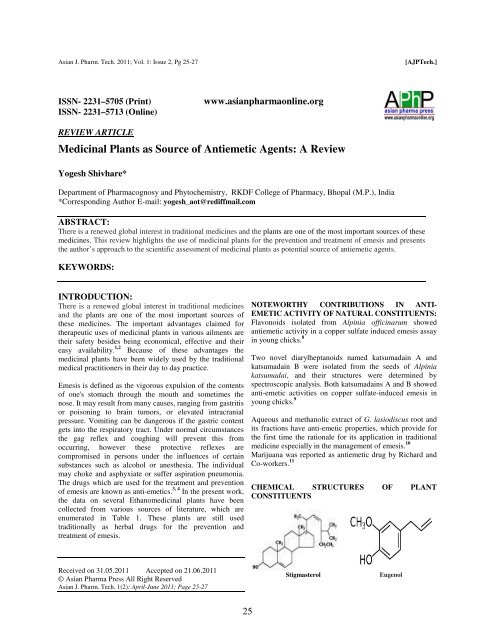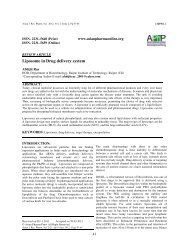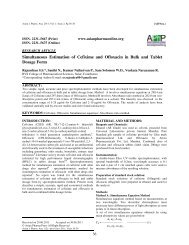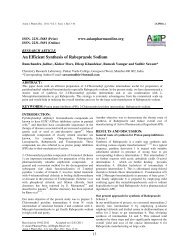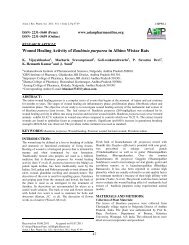Medicinal Plants as Source of Antiemetic Agents: A Review
Medicinal Plants as Source of Antiemetic Agents: A Review
Medicinal Plants as Source of Antiemetic Agents: A Review
Create successful ePaper yourself
Turn your PDF publications into a flip-book with our unique Google optimized e-Paper software.
Asian J. Pharm. Tech. 2011; Vol. 1: Issue 2, Pg 25-27<br />
[AJPTech.]<br />
ISSN- 2231–5705 (Print)<br />
www.<strong>as</strong>ianpharmaonline.org<br />
ISSN- 2231–5713 (Online) 0974-3618<br />
REVIEW ARTICLE<br />
<strong>Medicinal</strong> <strong>Plants</strong> <strong>as</strong> <strong>Source</strong> <strong>of</strong> <strong>Antiemetic</strong> <strong>Agents</strong>: A <strong>Review</strong><br />
Yogesh Shivhare*<br />
Department <strong>of</strong> Pharmacognosy and Phytochemistry, RKDF College <strong>of</strong> Pharmacy, Bhopal (M.P.), India<br />
*Corresponding Author E-mail: yogesh_aot@rediffmail.com<br />
ABSTRACT:<br />
There is a renewed global interest in traditional medicines and the plants are one <strong>of</strong> the most important sources <strong>of</strong> these<br />
medicines. This review highlights the use <strong>of</strong> medicinal plants for the prevention and treatment <strong>of</strong> emesis and presents<br />
the author’s approach to the scientific <strong>as</strong>sessment <strong>of</strong> medicinal plants <strong>as</strong> potential source <strong>of</strong> antiemetic agents.<br />
KEYWORDS:<br />
INTRODUCTION:<br />
There is a renewed global interest in traditional medicines<br />
and the plants are one <strong>of</strong> the most important sources <strong>of</strong><br />
these medicines. The important advantages claimed for<br />
therapeutic uses <strong>of</strong> medicinal plants in various ailments are<br />
their safety besides being economical, effective and their<br />
e<strong>as</strong>y availability. 1,2 Because <strong>of</strong> these advantages the<br />
medicinal plants have been widely used by the traditional<br />
medical practitioners in their day to day practice.<br />
Emesis is defined <strong>as</strong> the vigorous expulsion <strong>of</strong> the contents<br />
<strong>of</strong> one's stomach through the mouth and sometimes the<br />
nose. It may result from many causes, ranging from g<strong>as</strong>tritis<br />
or poisoning to brain tumors, or elevated intracranial<br />
pressure. Vomiting can be dangerous if the g<strong>as</strong>tric content<br />
gets into the respiratory tract. Under normal circumstances<br />
the gag reflex and coughing will prevent this from<br />
occurring, however these protective reflexes are<br />
compromised in persons under the influences <strong>of</strong> certain<br />
substances such <strong>as</strong> alcohol or anesthesia. The individual<br />
may choke and <strong>as</strong>phyxiate or suffer <strong>as</strong>piration pneumonia.<br />
The drugs which are used for the treatment and prevention<br />
<strong>of</strong> emesis are known <strong>as</strong> anti-emetics. 3, 4 In the present work,<br />
the data on several Ethanomedicinal plants have been<br />
collected from various sources <strong>of</strong> literature, which are<br />
enumerated in Table 1. These plants are still used<br />
traditionally <strong>as</strong> herbal drugs for the prevention and<br />
treatment <strong>of</strong> emesis.<br />
NOTEWORTHY CONTRIBUTIONS IN ANTI-<br />
EMETIC ACTIVITY OF NATURAL CONSTITUENTS:<br />
Flavonoids isolated from Alpinia <strong>of</strong>ficinarum showed<br />
antiemetic activity in a copper sulfate induced emesis <strong>as</strong>say<br />
in young chicks. 8<br />
Two novel diarylheptanoids named katsumadain A and<br />
katsumadain B were isolated from the seeds <strong>of</strong> Alpinia<br />
katsumadai, and their structures were determined by<br />
spectroscopic analysis. Both katsumadains A and B showed<br />
anti-emetic activities on copper sulfate-induced emesis in<br />
young chicks. 9<br />
Aqueous and methanolic extract <strong>of</strong> G. l<strong>as</strong>iodiscus root and<br />
its fractions have anti-emetic properties, which provide for<br />
the first time the rationale for its application in traditional<br />
medicine especially in the management <strong>of</strong> emesis. 10<br />
Marijuana w<strong>as</strong> reported <strong>as</strong> antiemetic drug by Richard and<br />
Co-workers. 11<br />
CHEMICAL STRUCTURES OF PLANT<br />
CONSTITUENTS<br />
Received on 31.05.2011 Accepted on 21.06.2011<br />
© Asian Pharma Press All Right Reserved<br />
Asian J. Pharm. Tech. 1(2): April-June 2011; Page 25-27<br />
Stigm<strong>as</strong>terol<br />
Eugenol<br />
25
Asian J. Pharm. Tech. 2011; Vol. 1: Issue 2, Pg 25-27<br />
[AJPTech.]<br />
Chlorogenic acid Glutathione Mangiferin Protopin<br />
TABLE 1. MEDICINAL PLANTS HAVING ANTIEMETIC ACTIVITY 5-7<br />
S. Botanical Name With Vernacular Family Part used Chemical Constituents<br />
N. Name<br />
1 Abutilon. Indicum (Kanghi) Malvaceae Bark Abutillin<br />
2 Achillea millefolium (Biranj<strong>as</strong>ipha) Compositae Herb Achillein and achilleic acid<br />
3 Allium tuberosum (Lah<strong>as</strong>un) Amaryllidaceae Bulb Trihydroxyspirostane<br />
4 Amomum krervanh (Krishna Jeera) Zingiberaceae Fruits Catechin - DPPH - epicatechin<br />
5 Annona. Squamosa.linn (Sharifa) Annonaceae Fruit Chloroplatinate, Anonaine Alkaloid<br />
6 Arundo phragmites (Cotton whitefly) Poaceae Stem Tricin flavone C-glycosides<br />
7 Atractylodes japonica (Anjani) Compositae Rhizome Hydroquinones<br />
8 Atractylodes lancea (Gurmar) Asteraceae Root 5-Lipoxygen<strong>as</strong>e and cyclooxygen<strong>as</strong>e-1<br />
9 Averrhoa.carambola (Kamrakh) Oxalidaceae Fruit Volatile oils<br />
10 Ballota nigra (Shalmali) Lamiaceae Whole Polyphenols, Phenylpropanoid, Mangiferin,<br />
plant<br />
11 Bixa.orellana.linn (Sinduriya) Bixaceae Plant Z-E Farnenyl Acetate, Occidentalo Acetate,<br />
12 Blighia sapida (Ackee) Sapindaceae Leaf, bark Hypoglycin A and B<br />
13 Br<strong>as</strong>sica.compestris. (Sarson) Cruciferae Seed Arabinan, Rhamnogalacturonan<br />
14 Calendula <strong>of</strong>ficinalis (Zergul) Asteraceae Florets Tarax<strong>as</strong>terol<br />
15 Carum carvi (Syahjeera) Apiaceae Seed Menthol<br />
16 Cetraria islandica (Charila) Parmeliaceae Fruit Alpha-methylene-gamma-lactone<br />
17 Cinnamomum verum (Dalchini) Lauraceae Fruit Eugenol, benzyl benzoate<br />
18 Citrus aurantifolia (Kagaji) Rutaceae Fruit Curcumin, acetoxychavicol acetate<br />
19 Citrus reticulata (Santara) Rutaceae Fruit 5, 4-dihydroxy-6, 7, 8, 3-tetramethoxy flavone<br />
20 Curcuma petiolata (Tavakhira) Zingiberaceae Rhizome Germacrone<br />
21 Eruca.sativa.gars (Arugula) Cruciferae Seed Carboxyl<strong>as</strong>e, Taramira,<br />
22 Fagonia.cretica.linn (Zarnab) Zygophyllaceae Leaves Cytosolic Copper<br />
23 Ferronia.elephantum (Kaitha) Rutaceae Fruit Carboxy Methylated (1-4)Polygala-Cturonan<br />
24 Hemerocallis fulva (Orange Daylily) Hemerocallidaceae Flower Kwanzoquinones, 2-hydroxychrysophanol<br />
25 Hibiscus.abelurosclua (Musk plant) Malvaceae Seed Glutathione, tannins<br />
26 Mesua.ferrea (Nagapushpa) Guttiferae Leaves 1-5,Dihydroxy Xanthone, B-Sitosterol<br />
27 Murraya.koenigii (Mitha nim) Rutaceae Leaves Carbazoles & Carbazoleguiaones,<br />
28 Ocimum gratissimum (Ram tulsi) Lamiaceae Whole Ocimum oil<br />
plant<br />
29 Ouratea.angustifolia (Vahl) Ochhaceae Root Gallocatechin<br />
30 Panax quinquefolium (Gurmar) Araliaceae Root Ginsenosides, polyacetylenic alcohols<br />
31 Pavonia.ododrata (Sugandhabala) Malvaceae All parts Sodium L. Malate<br />
32 Phragmites australis (Narkhat) Poaceae Stem Iso butyarate , propionate<br />
33 Phyllostachys nigra (Pecha) Poaceae Bark Chlorogenic acid, Caffeic acid,<br />
34 Pinellia ternata (Crow-dipper) Araceae Root Adenosine, guanosine, phenylalanine<br />
35 Portulaca.oleracea (Lunia) Portulacaceae Leaves Fruct<strong>as</strong>e, Oleracein, Lesperidin, Caffeic Acid<br />
36 Prunella vulgaris ( Ustakhadus) Lamiaceae Plant Stigm<strong>as</strong>terol<br />
37 Pueraria thunbergiana (Barali kund) Fabaceae Plant -hydroxy--methylglutaryl<br />
38 Sanguinaria canadensis (Arusa) Papaveraceae Root Sanguinarine, Chelerythrine and Protopine<br />
TABLE 2. HERBAL MARKETED PREPARATIONS CLAIMING ANTIEMETICS 12<br />
S.N. Brand Names Ingredients Mfd./Mkt. by<br />
1 Cordig<br />
(Tablet)<br />
Panchalavan 30mg, Triphala 30mg, Trikatu 20mg, Jeeraka 20mg, Sharapunkha 20mg,<br />
Pippalimoola 10mg, Vidanga 10mg, Bhringaraja 10mg, Ela 10mg, Talisapatra 10mg,<br />
Ajmera<br />
2 Vomiteb<br />
(Tablet/ Syrup)<br />
Tejpatra 10mg, Shankha bh<strong>as</strong>ma 10mg, Nimboo satwa 0.5mg<br />
Karpura twak 720mg, Mala 80mg, Chandana 40mg, Nimbu twak 40mg, Pippali 10mg, Teja<br />
10mg, Ela 10mg, Karpura 225mg, Suta Shekhara r<strong>as</strong>a 25mg, Lavanga 5mg<br />
Charak<br />
26
Asian J. Pharm. Tech. 2011; Vol. 1: Issue 2, Pg 25-27<br />
[AJPTech.]<br />
CONCLUSION:<br />
It can be concluded that present work is precious to find out<br />
natural products that may serve <strong>as</strong> lead for the improvement<br />
<strong>of</strong> new pharmaceuticals addressing the major therapeutic<br />
needs for the treatment <strong>of</strong> emesis.<br />
ACKNOWLEDGEMENT:<br />
Yogesh Shivhare, the author, thankfully acknowledges to<br />
Mr. Rakesh Punekar, Head and Vice-Principal, RKDF<br />
College <strong>of</strong> Pharmacy, Bhopal (M.P.), in preparation <strong>of</strong> this<br />
manuscript.<br />
REFERENCES<br />
1. Atal CK, Kapoor BM. Cultivation and utilization <strong>of</strong> medicinal<br />
plants. Eds. PID CSIR. 1989.<br />
2. Siddiqui HH. Safety <strong>of</strong> herbal drugs-an overview. Drugs News &<br />
Views. 1(2); 1993: 7–10.<br />
3. Hornby PJ. Central neurocircuitry <strong>as</strong>sociated with emesis. Am J<br />
Med. 2001: 111-106.<br />
4. Ray Andrew P, Chebolu Seetha, Ramirez Juan, Darmani Nissar<br />
A. Ablation <strong>of</strong> Le<strong>as</strong>t Shrew Central Neurokinin NK1 Receptors<br />
Reduces GR73632-Induced Vomiting. Behavioural<br />
Neuroscience. 123 (3); 2009: 701-706.<br />
5. Kirtikar KR, B<strong>as</strong>u BD. Indian <strong>Medicinal</strong> Plant. 1976: Vol. I to<br />
IV, 2nd ed, M/s Bishw<strong>as</strong> Singh, Nirali prak<strong>as</strong>an, Dehradun.<br />
6. Chaterjee Asima, Pakr<strong>as</strong>hi Satyesh Chandra. The Treatise <strong>of</strong><br />
Indian <strong>Medicinal</strong> <strong>Plants</strong>. 2003: Vol.5, 137.<br />
7. Williamson Elizabeth M. Major herbs <strong>of</strong> Ayurveda. Churchill<br />
livingstone. 2002.<br />
8. Diatetsu Shin, Kaoru Kinoshita, Kiyotaka Koyama, Kunio<br />
Takah<strong>as</strong>hi. <strong>Antiemetic</strong> Principles <strong>of</strong> Alpinia Officinarum. J. Nat.<br />
Prod. 65 (9); 2002: 1315-1318.<br />
9. Ye yang, Kaoki Kinoshita, Kiyotaka Koyama, Kunio Takah<strong>as</strong>hi,<br />
Takaaki Tai, Yeshiki Monovra & Kazuo Watanabe. Two novel<br />
antiemetic principles <strong>of</strong> Alpinia katsumadai. J. Nat Prod. 62(12);<br />
1999: 1672-1674.<br />
10. Tijani AY, Okhale SE, Oga FE, Tags SZ, Salawv OA, Chindo<br />
BA. <strong>Antiemetic</strong> activity <strong>of</strong> Grewia L<strong>as</strong>io discus root extract and<br />
fractions. African Journal <strong>of</strong> biotech. 7(17); 2008: 3011-3016.<br />
11. Richard H Schwartz, Roy A Bevertidge. Marijuana <strong>as</strong> an<br />
antiemetic drug. Journal <strong>of</strong> Addictive Dises<strong>as</strong>es.13(1); 1994:<br />
53-65.<br />
12. Arora Sakshi and Bajaj Sandhya. Advance Drug <strong>Review</strong>.<br />
Lucknow. 2007.<br />
27


